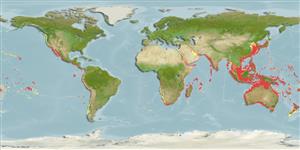Common names from other countries
Classification / Names / Names
Namen | Synonyme | Catalog of Fishes (gen., sp.) | ITIS | CoL | WoRMS
Environment: milieu / climate zone / depth range / distribution range
Ökologie
Riff-verbunden; tiefenbereich 0 - 222 m (Ref. 106682). Tropical
Southeast Atlantic and entire tropical Indo-Pacific from Red Sea and South Africa to the Hawaiian Islands.
Length at first maturity / Size / Gewicht / Alter
Maturity: Lm ? range ? - ? cm Max length : 12.0 cm WD Männchen/unbestimmt; (Ref. 800)
The five arms have blunt and tapered ends that curve slightly upwards. Both oral and aboral sides are flattened, with the aboral disc being slightly convex. Body color varies from greenish-blue, to brownish-gray and dark reddish-brown. This species is characterized by its distinctive laterally projecting rows of spines on the supero-marginal plate.
Buried in the sand during daytime and crawls on the sand to search for food at night. Feeds primarily on bivalves and gastropods and other small invertebrates buried in the sand (Ref. 800).
Life cycle and mating behavior
Geschlechtsreife | Fortpflanzung | Ablaichen | Eier | Fecundity | Larven
Members of the class Asteroidea exhibit both asexual (regeneration and clonal) and sexual (gonochoric) means of reproduction. Life cycle: Embryos hatch into planktonic larvae and later metamorphose into pentamorous juveniles which develop into young sea stars with stubby arms.
Schoppe, S. 2000. (Ref. 800)
IUCN Rote Liste Status (Ref. 130435)
CITES Status (Ref. 108899)
Not Evaluated
Not Evaluated
Bedrohung für Menschen
Harmless
Nutzung durch Menschen
| FishSource |
Tools
Mehr Information
Alter/GrößeWachstumLänge-GewichtLänge-LängeMorphologieLarvenDichte
Internet Quellen
Estimates based on models
Preferred temperature
(Ref.
115969): 15.3 - 29, mean 27.4 (based on 2738 cells).
Verwundbarkeit
Low vulnerability (10 of 100).
Preiskategorie
Unknown.
